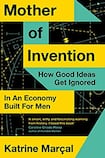
If the wheel was invented over 5,000 years ago, asks Katrine Marçal in this thought-provoking book, why wasn’t it applied to luggage until the 1970s?
A Swedish journalist based in London, Marçal is the author of Who Cooked Adam Smith’s Dinner? (2012), which explored the limitations of Homo economicus as an organising principle and the societal costs of devaluing unpaid labour.
In The Mother of Invention, seamlessly translated by Alex Fleming, Marçal investigates the impact of gender expectations on innovation. Wheelie suitcases did not take off until the 1970s because of macho assumptions that women were not meant to travel alone and that men should be strong enough to carry luggage, she explains.
“Our society’s ideas on masculinity are some of the most unyielding ideas we have, and our culture often values the preservation of certain concepts of masculinity over death itself.”
If death sounds dramatic, Marçal illustrates her point with the history of the automobile. What held back the development of the electric car, she argues, was less inadequate battery power than that its attributes – safety, silence, comfort – were considered to appeal to women. Would our current climate crisis look different, she wonders, if the electric car had not been considered feminine and, as such, inferior?
Playtex and Nasa
Fixed notions around gender shape not only the machines we build but what skills are valued. When Nasa put out to tender the project of making spacesuits for the Apollo mission, the company that produced bras and girdles under the brand name Playtex emerged far and away the winner. The company’s experience moulding latex to mould women proved invaluable: unlike metal armour, latex allowed astronauts to move. “Had it not been for the 1,000-year-old technology of the needle and thread, we would never have reached the moon,” writes Marçal. Although the spacesuits were sewn by expert seamstresses, a liaison had to be brought in to translate the knowhow into technical drawings to appease Nasa bureaucrats.
Nowhere is gender inequity clearer than the history of “computers” (the people, not the objects). Before the advent of calculating machines, women were employed as human calculators for about half the salary of men, and were among the earliest computer programmers. It was only when men were trained to program from the mid-1960s, however, that it became considered a skilled job, commanding higher pay.
Marçal fears that the same may happen with care work, predominantly done by women and woefully underpaid, as Madeleine Bunting documented in Labours of Love: The Crisis of Care (2020). If care work becomes one of a few skills difficult to outsource to Artificial Intelligence, it may attract more men and consequently become better remunerated.
“The problem isn’t that the men have snatched all the high-paid jobs,” notes Marçal. “The problem is that certain jobs are high paid because they are filled by men.” An abundance of cheap female labour also stymies innovation, she argues: “Who will want technology to solve problems that remain invisible, since they are currently being taken care of by women for free?”
‘Glamour labour’
Marçal also sets out the obstacles faced by female entrepreneurs. “Who gets to play a part in inventing our world? And who doesn’t?” she asks. “And what is the cost to us all?” Despite nearly 40 per cent of businesses in the US being owned by women, less than 3 per cent of venture capital investment goes to all-female founders. The consequences of male-led companies on product development (smartphones that don’t fit in women’s hands; cars not crash-tested for women’s bodies; implicit biases baked into AI) were detailed at length in Caroline Criado Perez’s Invisible Women (2019). “There’s nothing wrong with men,” Marçal reassures readers. “But there is something wrong with a system that shuts women out.”
With regards to “glamour labour” – female influencers on social platforms – while Kylie Jenner may be the highest earner on Instagram thanks to her billion-dollar make-up brand, the platform is owned by Mark Zuckerberg.
Mother of Invention challenges a multitude of deeply held cultural assumptions underlying our financial system. “The logic by which innovation must ‘dominate’, ‘crush’ and ‘disrupt’ has created an economy that is in many ways inhumane,” writes Marçal. What might have happened had we invested in developing alternative energy sources rather than spending on the cold war? The privileging of “hard” over “soft” technologies affects not only our view of history (classifying a Bronze Age rather than a Pottery Age, say) but has potential consequences for the future, as an overoptimism in innovation to combat climate change makes people less likely to make necessary behavioural changes.
Barring a brief detour into witch hunts and “mother nature”, which struck me as oddly woo-woo in the context of a book about economics, Mother of Invention had me nodding along in emphatic agreement. To tackle the substantial problems ahead, we simply cannot afford to continue to innovate “with one hand tied behind our backs”.

















